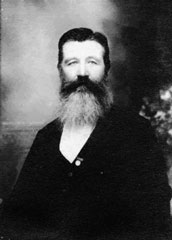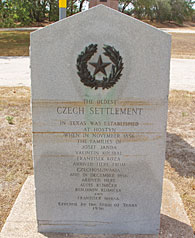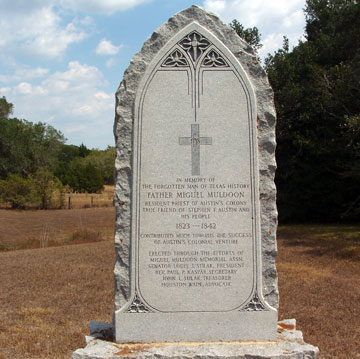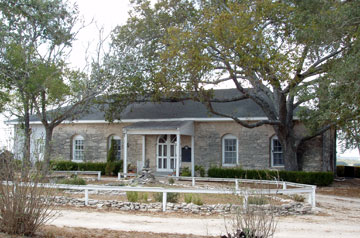Celebrations in Hostyn, Texas
Located six miles south of La Grange, Hostyn sits high on a hill that is the extension of the escarpment that includes the 200 foot bluff on the south side of the Colorado River; hence its old name of Bluff. Initially, Anglos settled in the area; however, by the 1840s, Germans were arriving. A log chapel was built in 1856 on the John Laux farm approximately three miles east of the present-day church. A faux wood replica of that chapel can now be found behind the church.
That same year, a group of Czech Moravians arrived, and soon the community reflected their heritage. By 1868, they built a Czech Catholic school and established a cemetery, followed by a larger church in 1869, all at the site of present-day Hostyn. The community was known as Bluff until the late1800s when it was called Moravan, the same name as the KJT lodge that was established there. The community eventually became a separate entity apart from the larger area that was known as Bluff, which actually had its own post office, two schools, two stores, a blacksmith shop and gin in several different locations.
There was another name change in 1925, when Rev. Paul Kaspar chose to name the community Hostyn in honor of a sacred place of religious pilgrimage in Moravia, a place that was located high on a hill just like his parish church.
Hostyn has a colorful history that includes multiple organizations, a theatrical group and a Sokol unit, which is a Czech organization that promotes healthy minds and bodies through competitive gymnastics and dancing. Celebrations were held for anniversary events, dedications and ordinations. There were also harvest festivals in the fall celebrating the blessings of bountiful crops. People brought food that they shared for their noon meal. Traveling by horse and wagon was a lengthy ordeal, so food was a necessity. Later, church picnics became popular, especially as money-making events. It seems that the people in Hostyn loved celebrations!
Unfortunately, the community suffered a severe drought in 1924 that devastated their livelihood, which depended upon their cotton crops. Everyone was on their knees praying for rain. In appreciation for the rains that eventually ended the drought in 1925, the parishioners built a somewhat smaller replica of a famous Catholic landmark, the grotto at Lourdes, France. It was their way to offer thanks for the rain in the best way they knew how. They gathered pieces of petrified wood, stone from old walls and rocks from the banks of the Colorado River to build the grotto that became a focal point on the parish grounds that have since been filled with other rock grottos and symbols of the Catholic faith.
The dedication of the grotto was most probably the most important event in the history of the church. Bishop Karel Kaspar of Hradec Kralove, Czechoslovakia, who later became an Archbishop and Cardinal, celebrated a Pontifical Mass in the Lourdes grotto chapel on Sunday, July 5, 1925, the Feast Day of Saints Cyril and Methodius according to the Czech liturgical calendar. It was reported that 5100 cars and 25,000 people attended this monumental event.
On July 4, 1929, there were another 20,000 people attending the solemn commemoration of the thousand year anniversary of the death of Saint Wenceslas, the patron saint of Bohemia. There were many more celebrations in Hostyn, including the Diamond Anniversary of the arrival of the Czech Moravians, together with a Slet (Meet) of the Catholic Sokol and Folk Fest that drew another huge crowd in 1931. However, one particular celebration piqued my interest based on an existing photograph.
 In 1926 a celebration, including a parade, was planned for the 70th anniversary of the first immigrants arriving in the Bluff community in 1856, as well as for their new school. The parade was documented with a photograph that shows a pair of steers pulling a wooden sled carrying three men, Tom Hruska of Ellinger, Rev. John Vanicek of Fayetteville and Alois J. Kallus of Wied, Texas. The identities and significance of these men and why they were together in this particular parade is interesting.
In 1926 a celebration, including a parade, was planned for the 70th anniversary of the first immigrants arriving in the Bluff community in 1856, as well as for their new school. The parade was documented with a photograph that shows a pair of steers pulling a wooden sled carrying three men, Tom Hruska of Ellinger, Rev. John Vanicek of Fayetteville and Alois J. Kallus of Wied, Texas. The identities and significance of these men and why they were together in this particular parade is interesting.
Tom Hruska, who as a young man, took the newly-arrived Rev. Joseph Chromcik from Ellinger to Fayetteville on his sled on Christmas Eve in 1872, so that Rev. Chromcik could surprise the Catholics with a Czech Mass and sermon. Although Hruska was not a Catholic, he and Rev. Chromcik became friends for life.
 Tom Hruska wore many hats; he was a farmer, teacher, surveyor and Precinct 2 judge. Being able to read and write, he became the first ever underage member of the CSPS Lodge in Ellinger and later became a member of the SPJST. Therefore, he was well-known throughout southeast Fayette County.
Tom Hruska wore many hats; he was a farmer, teacher, surveyor and Precinct 2 judge. Being able to read and write, he became the first ever underage member of the CSPS Lodge in Ellinger and later became a member of the SPJST. Therefore, he was well-known throughout southeast Fayette County.
Rev. Chromcik, the first Czech priest who served the Catholics in Fayetteville and many other mission parishes throughout central Texas, founded the Chromcik Catholic School in Fayetteville and was also instrumental in founding the KJT (The Czech Catholic Union of Texas) in Hostyn in 1889.
At the time of the 1926 celebration, Rev. John Vanicek, who was the resident priest at Fayetteville and also served the parish in Ellinger, was the KJT Chaplain. So he obviously knew Tom Hruska. Rev. Vanicek’s health became so bad after this celebration that he went back to the cool climate of his home in northeastern Bohemia for eight months to recover from his illness. When he returned to Texas, he was appointed pastor of the Catholic parish in Granger in late April, 1927.
Alois J. Kallus, who owned a general merchandise store in Wied near Shiner, Texas, was president of the KJT from 1923 to 1941.
Apparently, it was determined that the KJT organization should be represented in the 1926 celebration parade, because of its link to Hostyn’s history. Tom Hruska still owned the sled that transported Rev. Chromcik, the founder of the KJT, to Fayetteville, as well as the steers to pull it. Rev. Vanicek and Alois J. Kallus, being the chaplain and president, represented the KJT, so all three men rode together in the parade. The photograph of the three of them riding together was found in the rectory at the Catholic Church in Fayetteville, where Rev. Vanicek left it.
How did Tom Hruska get his sled and steers from his home close to St. Mary’s Catholic Church near Ellinger to Hostyn, Texas before the days of modern-day transportation methods? He probably loaded his sled onto a wagon that was pulled by his two steers and traveled on the old Columbus to La Grange Road, now Hwy 71. He would have had to spend the night in La Grange, because steers could only travel about 15 miles per day. He then crossed the Colorado River bridge west of town, went over the Buckner’s Creek bridge, up the old Bluff Road and proceeded on the old Schulenburg Road to Hostyn, where he watered and fed his steers and allowed them to rest for the night before the great parade the next day. Of course, that process had to be reversed to travel back home, so it was a five-day excursion for Hruska.
Although Mr. Kallus and Rev. Vanicek could travel to Hostyn by a Model-T type vehicle, it is highly likely that the vehicle transporting Rev. Vanicek from Fayetteville had to either have a full tank of fuel or would have had to be driven up the Bluff Road in reverse, because of the location of the gas tank beneath the front seat and the inability of the fuel pump to get gasoline to the engine on steep hills, especially with too little fuel.
How things have changed in 90 years! Thinking about traveling in those days should make us appreciate our modern vehicles that today we take for granted. It took preliminary preparations before any trip, and those traveling had little comfort with open-air vehicles on unpaved roads. However, being given the opportunity to participate in events like a celebration and parade in Hostyn obviously was worth it for all three men!
Photo Captions:
Tom Hruska, Rev. John Vanicek and A.J. Kallus riding on a sled in a 1926 parade in Hostyn, TX; courtesy of Joe Dybala Photography
Tom Hruska; Courtesy of Fayette Heritage Library and Archives
Sources:
A History of Czech-Moravian Catholic Communities of Texas, translated and edited by Rev. V. A. Svrcek; 1974
Handbook of Texas, online
History of the Queen of the Holy Rosary Parish, Parish History Committee, 1981
Morkovsky, Msgr. Alois J.; “Short Biographies of Czech and Other Priests in Texas; 1982
“Queen of the Holy Rosary Church, Hostyn”; Fayette County, Texas Heritage, Vol. 1; Curtis Media, 1996
St. Mary’s Church near Ellinger, Texas; Parish History Committee; 1986
The Czech Catholic Union of Texas Centennial History, 1889 – 1989; KJT, 1989
Wikipedia
 The Oldest Czech Settlement In Texas
The Oldest Czech Settlement In Texas

 In 1926 a celebration, including a parade, was planned for the 70th anniversary of the first immigrants arriving in the Bluff community in 1856, as well as for their new school. The parade was documented with a photograph that shows a pair of steers pulling a wooden sled carrying three men, Tom Hruska of Ellinger, Rev. John Vanicek of Fayetteville and Alois J. Kallus of Wied, Texas. The identities and significance of these men and why they were together in this particular parade is interesting.
In 1926 a celebration, including a parade, was planned for the 70th anniversary of the first immigrants arriving in the Bluff community in 1856, as well as for their new school. The parade was documented with a photograph that shows a pair of steers pulling a wooden sled carrying three men, Tom Hruska of Ellinger, Rev. John Vanicek of Fayetteville and Alois J. Kallus of Wied, Texas. The identities and significance of these men and why they were together in this particular parade is interesting.  Tom Hruska wore many hats; he was a farmer, teacher, surveyor and Precinct 2 judge. Being able to read and write, he became the first ever underage member of the CSPS Lodge in Ellinger and later became a member of the SPJST. Therefore, he was well-known throughout southeast Fayette County.
Tom Hruska wore many hats; he was a farmer, teacher, surveyor and Precinct 2 judge. Being able to read and write, he became the first ever underage member of the CSPS Lodge in Ellinger and later became a member of the SPJST. Therefore, he was well-known throughout southeast Fayette County. 
